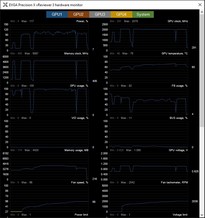Custom GeForce GTX 1080 Round Up With ASUS, EVGA, And Gigabyte
Overclocking, Power Consumption, Noise, and Temps
We also spent a little time overlcocking these custom GeForce GTX 1080 cards, to see what kind of additional performance they had left under their respective hoods. Before we get to our results, though, we need to talk about GPU Boost and how it works.
Pascal-based GeForces feature GPU Boost 3.0. Like previous-gen GeForce cards, GPU Boost scales frequencies and voltages upwards, power and temperature permitting, based on the GPU's workload at the time. With GPU Boost 2.0, which debuted on Maxwell, you could overclock using a fixed frequency offset and bump up the GPU voltage curve manually, but that left some performance on the table because it doesn't offer the kind of granular control necessary to massage every last MHz out of a given chip. With GPU Boost 3.0, however, you can now manually set the frequency offset on a per voltage point basis. In addition, overclocking / monitoring utilities like EVGA's Precision X gives users the ability to run a tool that automatically finds a GTX 1080 GPU's peak frequency at each available voltage point. The tool basically runs Furmark and tests for stability, while incrementally upping the GPU frequency per voltage point. When instability or image anomalies are detected, the tool logs the peak "good" frequency and moves on to the next voltage step. You eventually end up with a customized overclocking profile, optimized for your particular GPU. These profiles will be different for every card.
We did not create a custom profile for each of the cards tested here. Instead, we cranked up the power target to 120% and kicked up the temperature target to 91 degrees. Then we bumped up the GPU clocks until the test system was no longer stable. We did not tweak fan speeds or voltages. Our goal was to find the maximum GPU clock for each card, without excessive tweaking, to give you all a realistic target and to see what temperatures looks like using the default profile. Of course, tweaking voltages and fan speeds would change the results (and potentially create more noise), but since there are so many potential variables, we kept things simple and straightforward.
 ASUS GTX 1080 STRIX |  EVGA GTX 1080 SC |  Gigabyte GTX 1080 G1 |
The results of our efforts are outlined in the images above. This is data captured from each card using EVGA's Precision X utility, that shows the max temperatures, GPU frequencies, and the like after a number of of benchmark runs with actual games. As you can see, all three cards broke the 2GHz barrier. The EVGA and ASUS cards peaked at 2075MHz, while Gigabyte's offering hit 2025MHz. The Gigabyte card, however, maintained the lowest temperatures. All three of the cards never came close to hitting the maximum temperature target, though. The coolers on these cards have absolutely no trouble keeping the GP104 cool.


While we had the card overclocked, we re-ran a couple of tests and saw some moderate improvements in performance in the games / settings we tested. Because all three cards were already factory overclocked, the additional bumps in performance aren't huge, but versus a stock GTX 1080, the increases are in the 10% - 12% range.
|
|

At their stock settings, all three of the custom GeForce GTX 1080 cards we tested consumed similar amounts of power at idle. There were slight differences under load, but we're only talking about a few watts overall.
We should also mention that temperatures on these GeForce GTX 1080 card are very good as well. At idle, the cards' GPUs hovered in the upper-30s to 40 degrees C. And under sustained load, even while overclocked, the GPUs temps only shot up into the high 70'C - 80'C range.

In terms of its noise output, all of these GeForce GTX 1080 cards are very quiet as well. When idling, because their fans don't spin at all, there is no noise produced by these cards. Under load, once temperatures have increased, their fans do spin up, but all of the cards remained what we would consider quiet. We should note, however, that much of the additional noise under load in this graph can be attributed to our test system's power supply and CPU cooler. All of these graphics cards are relatively quiet under load, especially if you test inside a chassis like we do.






